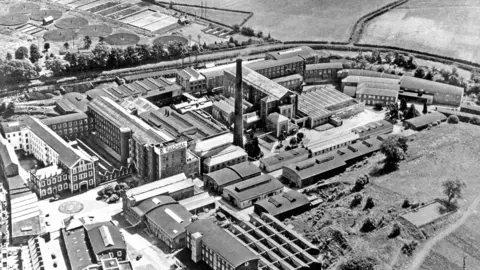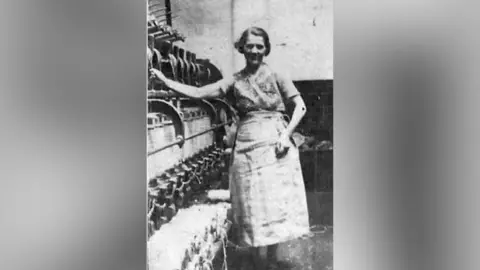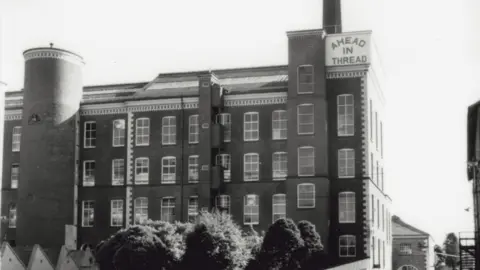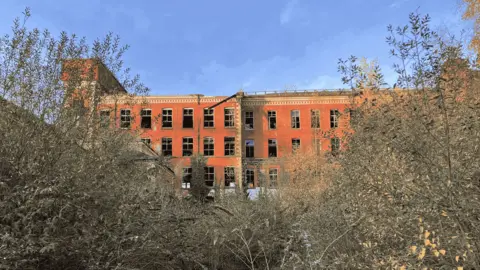I met most of my friends working at Hilden Mill
 Shirley McMichael
Shirley McMichaelFor decades, a now-derelict mill near Lisburn in County Antrim, employed generations of women and men.
But for many Hilden Mill was more than just a workplace – it was a thread that connected families and was a source of shared history.
One of those women was Shirley McMichael who found herself working in the laboratories at Hilden Mill in 1967 – she was just 15-years-old.
"My role was all about testing the colours, finishes and the threads.
"I would go up and down the building collecting my thread samples from the dye houses."
Hilden Mill supplied M&S
Mrs McMichael said during her time working at the mill, a lot of work was done for popular retailer Marks and Spencer.
"The boys in the dye houses would have to match up various threads before I would run tests to make sure the dye wouldn't run, that it was the right finish for the end product, as well as the best finish we could achieve," she explained.
"If it worked out well, then Marks and Spencer would have bought it.
"Seeing the thread being dyed on an industrial scale was just fascinating to look at."
 Irish Linen Centre & Lisburn Museum
Irish Linen Centre & Lisburn MuseumOne of world's largest linen producers
The site began as a linen bleaching green before being transformed in 1823 by William Barbour, whose father had settled in Lisburn from Scotland four decades earlier.
Mr Barbour established a water-powered mill at Hilden, which historians say grew into one of the world's largest producers of linen thread.
Over time, the Barbour family became a major employer in the area and developed a model village to house and support their workers. This included hundreds of homes, two schools, a community hall, a sports ground and a children's playground.
Mrs McMichael, who is in her 70s, remembers her time at Hilden Mill fondly and said the history and heritage of the site are well known.
 Shirley McMichael
Shirley McMichael"All the women in my family worked there at some point," she said. "My granny was employed there in the early 1900s and often shared stories about her time during the First World War.
"I remember my mum and granny talking about the Battle of the Somme and the thousands of people killed in it from Northern Ireland, and the way the mill brought a lot of families together to share in their sorrow and support for each other."
 Irish Linen Centre & Lisburn Museum
Irish Linen Centre & Lisburn Museum"My mum and sister worked in the spinning room at the same time I was in the laboratories, and I used to be able to pop in and see them.
"They used to tease me that I didn't have to work as hard as they did because I would have time between tasks to do a lot of knitting. I'd come home with a new top fashioned and they'd have a laugh at me."
But beyond the work, it was the friendships and camaraderie that left a lasting impression.
"It's where I met so many of my girlfriends growing up," she said.
"Just last week I bumped into one of my good friends that I used to work with in the labs that I hadn't seen for ages. It was funny and we both started talking about all the happy memories of the mill."
 Irish Linen Centre & Lisburn Museum
Irish Linen Centre & Lisburn Museum Irish Linen Centre & Lisburn Museum
Irish Linen Centre & Lisburn MuseumThe mill has been a listed building since 1989, with several redevelopment proposals put forward since its closure in 2006.
However, the site has been subject to vandalism and arson attacks.
The buildings are currently owned by PJK Developments, based in Warwickshire, and they have sought permission to demolish all but two of the buildings on the site.
Last October, a consultant for the company told BBC News NI that it would not be financially viable to redevelop the site without the demolition.
The developers are hoping that the remaining two buildings could be retained and redeveloped for community use.
'Wound on the local community'
 LDRS
LDRSLisburn and Castlereagh City Council have already agreed a motion to protect Hilden Mill's historical and architectural integrity, ensuring that any future development preserves key elements of the site for future generations.
Independent councillor Gary Hynds, who was behind the motion, said: "It's very much become somewhat of a wound on the local community – we're talking about a world famous building with so much history behind it.
"Hopefully this will put pressure on the council and Stormont to take action and put more focus on the future of the site.
"There are places all over the world that look after their history, which does cost money but we can't allow another site to completely deteriorate into nothing and be forgotten about."
He added: "My focus is on ensuring that whatever development does occurs that the history and heritage is very much recognised."
'No consent granted for demolition'
In a statement to BBC News NI, Lisburn and Castlereagh City Council (LCCC) said that "no consent has been granted for the demolition of Hilden Mill" due to "a presumption against the loss of significant heritage assets".
The council said it "remains committed to engaging constructively with the mill's owners to explore sustainable uses that preserve the site's architectural and historical significance".
"While the council has facilitated meetings with potential developers, no redevelopment proposals have been submitted to date."
It said the Historic Environment Division (HED) of the Department for Communities had been "actively involved" in all discussions concerning the site's future.
A spokesperson for the Department for Communities said: "There are no proposals currently, but HED will provide advice to the council and seek to ensure proposals retain listed structures, and any new development is appropriate with the Mill's special architectural and historic character."
